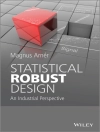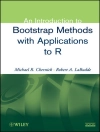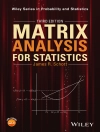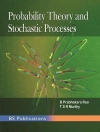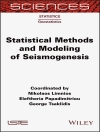Complete guidance for mastering the tools and techniques of the digital revolution
With the digital revolution opening up tremendous opportunities in many fields, there is a growing need for skilled professionals who can develop data-intensive systems and extract information and knowledge from them. This book frames for the first time a new systematic approach for tackling the challenges of data-intensive computing, providing decision makers and technical experts alike with practical tools for dealing with our exploding data collections.
Emphasizing data-intensive thinking and interdisciplinary collaboration, The Data Bonanza: Improving Knowledge Discovery in Science, Engineering, and Business examines the essential components of knowledge discovery, surveys many of the current research efforts worldwide, and points to new areas for innovation. Complete with a wealth of examples and DISPEL-based methods demonstrating how to gain more from data in real-world systems, the book:
- Outlines the concepts and rationale for implementing data-intensive computing in organizations
- Covers from the ground up problem-solving strategies for data analysis in a data-rich world
- Introduces techniques for data-intensive engineering using the Data-Intensive Systems Process Engineering Language DISPEL
- Features in-depth case studies in customer relations, environmental hazards, seismology, and more
- Showcases successful applications in areas ranging from astronomy and the humanities to transport engineering
- Includes sample program snippets throughout the text as well as additional materials on a companion website
The Data Bonanza is a must-have guide for information strategists, data analysts, and engineers in business, research, and government, and for anyone wishing to be on the cutting edge of data mining, machine learning, databases, distributed systems, or large-scale computing.
Inhaltsverzeichnis
CONTRIBUTORS xv
FOREWORD xvii
PREFACE xix
THE EDITORS xxix
PART I STRATEGIES FOR SUCCESS IN THE DIGITAL-DATA REVOLUTION 1
1. The Digital-Data Challenge 5
Malcolm Atkinson and Mark Parsons
1.1 The Digital Revolution 5
1.2 Changing How We Think and Behave 6
1.3 Moving Adroitly in this Fast-Changing Field 8
1.4 Digital-Data Challenges Exist Everywhere 8
1.5 Changing How We Work 9
1.6 Divide and Conquer Offers the Solution 10
1.7 Engineering Data-to-Knowledge Highways 12
2. The Digital-Data Revolution 15
Malcolm Atkinson
2.1 Data, Information, and Knowledge 16
2.2 Increasing Volumes and Diversity of Data 18
2.3 Changing the Ways We Work with Data 28
3. The Data-Intensive Survival Guide 37
Malcolm Atkinson
3.1 Introduction: Challenges and Strategy 38
3.2 Three Categories of Expert 39
3.3 The Data-Intensive Architecture 41
3.4 An Operational Data-Intensive System 42
3.5 Introducing DISPEL 44
3.6 A Simple DISPEL Example 45
3.7 Supporting Data-Intensive Experts 47
3.8 DISPEL in the Context of Contemporary Systems 48
3.9 Datascopes 51
3.10 Ramps for Incremental Engagement 54
3.11 Readers’ Guide to the Rest of This Book 56
4. Data-Intensive Thinking with DISPEL 61
Malcolm Atkinson
4.1 Processing Elements 62
4.2 Connections 64
4.3 Data Streams and Structure 65
4.4 Functions 66
4.5 The Three-Level Type System 72
4.6 Registry, Libraries, and Descriptions 81
4.7 Achieving Data-Intensive Performance 86
4.8 Reliability and Control 108
4.9 The Data-to-Knowledge Highway 116
PART II DATA-INTENSIVE KNOWLEDGE DISCOVERY 123
5. Data-Intensive Analysis 127
Oscar Corcho and Jano van Hemert
5.1 Knowledge Discovery in Telco Inc. 128
5.2 Understanding Customers to Prevent Churn 130
5.3 Preventing Churn Across Multiple Companies 134
5.4 Understanding Customers by Combining Heterogeneous Public and Private Data 137
5.5 Conclusions 144
6. Problem Solving in Data-Intensive Knowledge Discovery 147
Oscar Corcho and Jano van Hemert
6.1 The Conventional Life Cycle of Knowledge Discovery 148
6.2 Knowledge Discovery Over Heterogeneous Data Sources 155
6.3 Knowledge Discovery from Private and Public, Structured and Nonstructured Data 158
6.4 Conclusions 162
7. Data-Intensive Components and Usage Patterns 165
Oscar Corcho
7.1 Data Source Access and Transformation Components 166
7.2 Data Integration Components 172
7.3 Data Preparation and Processing Components 173
7.4 Data-Mining Components 174
7.5 Visualization and Knowledge Delivery Components 176
8. Sharing and Reuse in Knowledge Discovery 181
Oscar Corcho
8.1 Strategies for Sharing and Reuse 182
8.2 Data Analysis Ontologies for Data Analysis Experts 185
8.3 Generic Ontologies for Metadata Generation 188
8.4 Domain Ontologies for Domain Experts 189
8.5 Conclusions 190
PART III DATA-INTENSIVE ENGINEERING 193
9. Platforms for Data-Intensive Analysis 197
David Snelling
9.1 The Hourglass Reprise 198
9.2 The Motivation for a Platform 200
9.3 Realization 201
10. Definition of the DISPEL Language 203
Paul Martin and Gagarine Yaikhom
10.1 A Simple Example 204
10.2 Processing Elements 205
10.3 Data Streams 213
10.4 Type System 217
10.5 Registration 222
10.6 Packaging 224
10.7 Workflow Submission 225
10.8 Examples of DISPEL 227
10.9 Summary 235
11. DISPEL Development 237
Adrian Mouat and David Snelling
11.1 The Development Landscape 237
11.2 Data-Intensive Workbenches 239
11.3 Data-Intensive Component Libraries 247
11.4 Summary 248
12. DISPEL Enactment 251
Chee Sun Liew, Amrey Krause, and David Snelling
12.1 Overview of DISPEL Enactment 251
12.2 DISPEL Language Processing 253
12.3 DISPEL Optimization 255
12.4 DISPEL Deployment 266
12.5 DISPEL Execution and Control 268
PART IV DATA-INTENSIVE APPLICATION EXPERIENCE 275
13. The Application Foundations of DISPEL 277
Rob Baxter
13.1 Characteristics of Data-Intensive Applications 277
13.2 Evaluating Application Performance 280
13.3 Reviewing the Data-Intensive Strategy 283
14. Analytical Platform for Customer Relationship Management 287
Maciej Jarka and Mark Parsons
14.1 Data Analysis in the Telecoms Business 288
14.2 Analytical Customer Relationship Management 289
14.3 Scenario 1: Churn Prediction 291
14.4 Scenario 2: Cross Selling 293
14.5 Exploiting the Models and Rules 296
14.6 Summary: Lessons Learned 299
15. Environmental Risk Management 301
Ladislav Hluchy, Ondrej Habala, Viet Tran, and Branislav Simo
15.1 Environmental Modeling 302
15.2 Cascading Simulation Models 303
15.3 Environmental Data Sources and Their Management 305
15.4 Scenario 1: ORAVA 309
15.5 Scenario 2: RADAR 313
15.6 Scenario 3: SVP 318
15.7 New Technologies for Environmental Data Mining 321
15.8 Summary: Lessons Learned 323
16. Analyzing Gene Expression Imaging Data in Developmental Biology 327
Liangxiu Han, Jano van Hemert, Ian Overton, Paolo Besana, and Richard Baldock
16.1 Understanding Biological Function 328
16.2 Gene Image Annotation 330
16.3 Automated Annotation of Gene Expression Images 331
16.4 Exploitation and Future Work 341
16.5 Summary 345
17. Data-Intensive Seismology: Research Horizons 353
Michelle Galea, Andreas Rietbrock, Alessandro Spinuso, and Luca Trani
17.1 Introduction 354
17.2 Seismic Ambient Noise Processing 356
17.3 Solution Implementation 358
17.4 Evaluation 369
17.5 Further Work 372
17.6 Conclusions 373
PART V DATA-INTENSIVE BEACONS OF SUCCESS 377
18. Data-Intensive Methods in Astronomy 381
Thomas D. Kitching, Robert G. Mann, Laura E. Valkonen, Mark S. Holliman, Alastair Hume, and Keith T. Noddle
18.1 Introduction 381
18.2 The Virtual Observatory 382
18.3 Data-Intensive Photometric Classification of Quasars 383
18.4 Probing the Dark Universe with Weak Gravitational Lensing 387
18.5 Future Research Issues 392
18.6 Conclusions 392
19. The World at One’s Fingertips: Interactive Interpretation of Environmental Data 395
Jon Blower, Keith Haines, and Alastair Gemmell
19.1 Introduction 395
19.2 The Current State of the Art 397
19.3 The Technical Landscape 401
19.4 Interactive Visualization 403
19.5 From Visualization to Intercomparison 406
19.6 Future Development: The Environmental Cloud 409
19.7 Conclusions 411
20. Data-Driven Research in the Humanities—the DARIAH Research Infrastructure 417
Andreas Aschenbrenner, Tobias Blanke, Christiane Fritze, and Wolfgang Pempe
20.1 Introduction 417
20.2 The Tradition of Digital Humanities 420
20.3 Humanities Research Data 422
20.4 Use Case 426
20.5 Conclusion and Future Development 429
21. Analysis of Large and Complex Engineering and Transport Data 431
Jim Austin
21.1 Introduction 431
21.2 Applications and Challenges 432
21.3 The Methods Used 434
21.4 Future Developments 438
21.5 Conclusions 439
References 440
22. Estimating Species Distributions—Across Space, Through Time, and with Features of the Environment 441
Steve Kelling, Daniel Fink, Wesley Hochachka, Ken Rosenberg, Robert Cook, Theodoros Damoulas, Claudio Silva, and William Michener
22.1 Introduction 442
22.2 Data Discovery, Access, and Synthesis 443
22.3 Model Development 448
22.4 Managing Computational Requirements 449
22.5 Exploring and Visualizing Model Results 450
22.6 Analysis Results 452
22.7 Conclusion 454
PART VI THE DATA-INTENSIVE FUTURE 459
23. Data-Intensive Trends 461
Malcolm Atkinson and Paolo Besana
23.1 Reprise 461
23.2 Data-Intensive Applications 469
24. Data-Rich Futures 477
Malcolm Atkinson
24.1 Future Data Infrastructure 478
24.2 Future Data Economy 485
24.3 Future Data Society and Professionalism 489
References 494
Appendix A: Glossary 499
Michelle Galea and Malcolm Atkinson
Appendix B: DISPEL Reference Manual 507
Paul Martin
Appendix C: Component Definitions 531
Malcolm Atkinson and Chee Sun Liew
INDEX 537
Über den Autor
MALCOLM ATKINSON, Ph D, is Professor of e-Science in the School of Informatics at the University of Edinburgh in Scotland. He is also Data-Intensive Research Group leader, Director of the e-Science Institute, IT architect for the ADMIRE and VERCE EU projects and UK e-Science Envoy. Professor Atkinson has been leading research projects for several decades and served on many advisory bodies.







